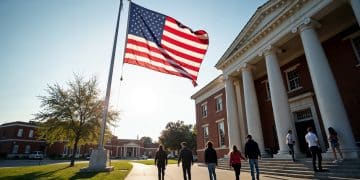Immigration Reform: Key Policy Changes to Watch in the Next 6 Months

Immigration reform in the next six months faces potential shifts in policy, influenced by ongoing legal challenges, political pressures, and administrative adjustments affecting border security, asylum processes, and pathways to legal status.
The landscape of immigration policy is ever-evolving. Understanding the key shifts and potential changes is crucial. This article dives into the significant policy areas undergoing transformation and anticipated changes in immigration law within the next six months, specifically focusing on immigration reform: key policy changes to watch for in the next 6 months.
Anticipated Executive Actions and Policy Memoranda
Executive actions and policy memoranda often serve as immediate levers for implementing changes in immigration policy. These directives can significantly alter enforcement priorities, streamline administrative processes, and introduce new interpretations of existing laws.
Potential Areas of Focus
With the current administration, there are several arenas where executive actions might play a pivotal role. This includes border enforcement strategies, the handling of asylum claims, and adjustments to existing immigration programs. For example, we might see changes in the “Remain in Mexico” policy, or new directives outlining how asylum applications are to be processed.
Impact and Legal Challenges
Executive actions are often swift in their implementation, but they don’t always escape legal scrutiny. Federal courts can and often do issue injunctions, temporarily or permanently blocking the enforcement of these policies. Therefore, tracking not only the issuance of these directives but also their subsequent legal journey is essential.

Monitoring these actions and challenges provides insights into the administration’s evolving stance on immigration and the judiciary’s role in shaping these policies.
Congressional Bills and Legislative Developments
Beyond executive actions, legislative initiatives in Congress can bring more permanent and comprehensive changes to immigration law. Although legislative progress can be slower and more contentious, any successful bill has the potential to reshape the legal framework for years to come.
Key Bills to Watch
Several bills related to immigration are currently under consideration in Congress. These span a wide array of issues, including border security, pathways to citizenship, and reforms to the visa system. Key pieces of legislation may include:
- The DREAM Act: Aimed at providing a pathway to citizenship for undocumented immigrants brought to the US as children.
- Border Security Enhancement Act: Focused on increased funding and resources for border control.
- The Farm Workforce Modernization Act: Seeking to address labor shortages in the agricultural sector by reforming visa programs for farmworkers.
Obstacles and Bipartisan Efforts
Due to the highly partisan nature of immigration debates, passing comprehensive immigration reform legislation is a significant challenge. However, there are areas where bipartisan cooperation is possible, such as targeted reforms to address specific issues like agricultural labor shortages or to improve border security technology.
Tracking these legislative efforts and identifying areas of potential compromise or contention will be essential in understanding the long-term trajectory of immigration reform.
Changes to Visa Programs and Work Permits
Visa programs and work permits are essential components of the US immigration system, facilitating the entry of skilled workers, students, and temporary laborers. Changes to these programs can have a significant impact on businesses, educational institutions, and individuals seeking opportunities in the US.
Potential Adjustments to H-1B and Other Visas
The H-1B visa, which allows US companies to employ foreign workers in specialty occupations, is often a subject of debate and reform efforts. We might see adjustments to the eligibility criteria, the allocation process, or the enforcement of regulations to prevent abuse. Additionally, other visa programs like the H-2A for temporary agricultural workers and the J-1 for exchange visitors could also undergo changes to address specific needs or concerns.
Impact on Industries and Workers
Adjustments to visa programs can have far-reaching consequences for various industries. For example, stricter H-1B requirements could affect the tech sector’s ability to attract top talent. Changes to the H-2A program could impact the agricultural industry’s access to labor. Monitoring these potential changes is crucial for businesses and workers alike.
Reforming visa programs can support industries needing specialized workers and ensure fairness and compliance within the system.
Asylum and Refugee Policies
Asylum and refugee policies reflect a nation’s humanitarian values and its obligations under international law. These policies determine who can seek protection in the US and how their claims are processed. Significant changes in these areas can have profound effects on vulnerable populations and the integrity of the asylum system.
Modifications in Asylum Procedures
The asylum process has been a focal point of recent changes, with new rules affecting eligibility criteria, processing times, and access to legal representation. These modifications include:
- The implementation of stricter standards for credible fear interviews, which determine whether an asylum seeker can proceed with their application.
- The expansion of expedited removal processes, which allow immigration officials to quickly deport individuals without a hearing before an immigration judge.
- Restrictions on asylum eligibility for individuals who have transited through other countries before reaching the US.
International Cooperation and Humanitarian Concerns
Asylum and refugee policies are not solely domestic issues; they require international cooperation and consideration of humanitarian concerns. The US government engages with international organizations and other countries to address refugee crises and provide assistance to displaced populations. Balancing border security concerns with humanitarian obligations remains a significant challenge.
The government continues to reform asylum policies to deal with strains on resources when processing refugee claims.
Border Security and Enforcement Strategies
Border security remains a critical aspect of immigration policy, influencing not only the flow of people and goods but also the overall perception of national security. Changes in enforcement strategies can have tangible effects on border communities and the lives of migrants.

Technological Advancements and Infrastructure
Investments in technology and infrastructure play a key role in enhancing border security. This includes the deployment of surveillance equipment, the construction of physical barriers, and the use of data analytics to detect and prevent illegal activity. For example:
- The expansion of drone surveillance to monitor remote areas of the border.
- The implementation of biometric screening technologies to identify individuals attempting to enter the country illegally.
- The utilization of artificial intelligence to analyze large datasets and identify patterns of illegal activity.
Deterrence Measures and Community Impacts
Enforcement strategies also include measures aimed at deterring illegal immigration, such as increased patrols, stricter penalties for smuggling, and collaborations with local law enforcement agencies. However, these measures can also have unintended consequences, impacting border communities and potentially leading to human rights concerns. For example:
- Increased enforcement efforts can divert migrants to more dangerous routes, increasing the risk of injury or death.
- The militarization of the border can lead to tensions with border communities and erode trust between residents and law enforcement.
- The separation of families due to deportation can have devastating effects on children and communities.
These border security efforts are intended to keep the border and its surrounding communities safer.
State and Local Immigration Policies
While immigration law is primarily a federal matter, state and local governments play an important role in shaping immigration policies within their jurisdictions. These policies can range from cooperation with federal enforcement efforts to the provision of services and protections for immigrant communities.
Sanctuary Policies and Legal Challenges
“Sanctuary policies,” which limit cooperation between state and local law enforcement agencies and federal immigration authorities, have been a subject of intense debate and legal challenges. Supporters argue that these policies protect immigrant communities and promote trust between residents and law enforcement, while opponents claim that they undermine federal law and endanger public safety. These policies can include:
- Restrictions on local law enforcement officers inquiring about immigration status during routine stops.
- Limitations on the sharing of information with federal immigration authorities.
- The creation of safe zones, such as schools and hospitals, where immigration enforcement actions are restricted.
State-Level Legislation and Enforcement
In addition to sanctuary policies, state legislatures can enact laws addressing a wide range of immigration-related issues, such as access to education, healthcare, and driver’s licenses for undocumented immigrants. These laws can vary significantly from state to state, creating a patchwork of immigration policies across the country.
State and local immigration policies often aim to safeguard local communities by providing legal guidance and state-funded enforcement.
| Key Element | Brief Description |
|---|---|
| 📝 Executive Actions | Presidential directives that can quickly alter immigration enforcement and policy. |
| 🏛️ Congressional Bills | Legislative efforts in Congress to reform immigration laws, including border security and visa programs. |
| 🛂 Visa Programs | Potential changes to programs like H-1B and H-2A visas affecting skilled and agricultural workers. |
| 🛡️ Border Security | Implementation of technology and infrastructure to prevent illegal immigration and secure the border. |
Frequently Asked Questions
▼
The DREAM Act is currently under consideration in Congress, aiming to provide a pathway to citizenship for undocumented immigrants brought to the U.S. as children, but its future remains highly uncertain due to partisan divisions.
▼
Asylum procedures may change through stricter eligibility criteria, faster processing times, and limited access to legal help, which affects who can seek protection in the U.S.
▼
Sanctuary policies limit how much state and local police work with federal immigration authorities, protecting immigrant communities and building trust, but they face criticism for potentially undermining federal law.
▼
Border security is enhanced by technological progress, including surveillance systems, border barriers, and the use of data analytics to detect and prevent unlawful activities.
▼
Changes to visa programs can drastically affect different industries, like how strict H-1B requirements impact the tech industry’s ability to attract skilled professionals.
Conclusion
As we look ahead, the landscape of immigration policy in the US promises to be dynamic. By closely monitoring executive actions, legislative developments, changes to visa programs, asylum policies, border security strategies, and state-level initiatives, stakeholders can better understand and navigate the evolving immigration landscape.





